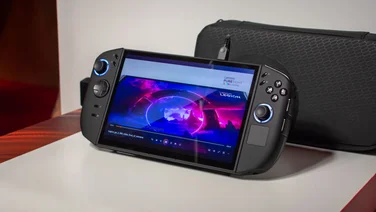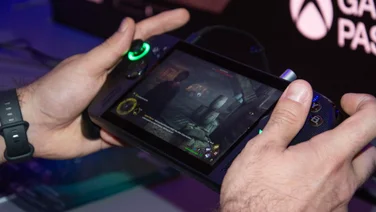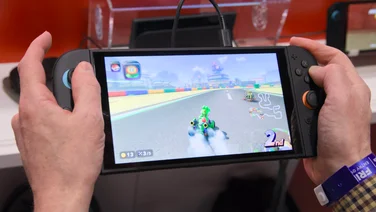To help us provide you with free impartial advice, we may earn a commission if you buy through links on our site. Learn more















- Larger OLED screen is a delight
- New kickstand is a huge improvement
- Only £50 more than regular model
- No internal hardware upgrades
- Still uses the same drift-prone Joy-Cons
With the launch of the original Switch, Nintendo created a whole new category of games machine. Effectively two consoles in one, the Switch was a force to be reckoned with: a gaming hybrid that could either be plugged into your TV or removed from its docking station for on-the-go handheld play.
But that was 2017. Since then, Nintendo hasn’t really changed the formula, outside of the handheld-only Switch Lite, which launched two years after the original release. With the PlayStation 5 and Xbox Series X already setting the stage for next-gen gaming, the Switch’s ambidextrous design and low-powered hardware might be getting a little bit stale.
In an effort to keep the Switch firmly in the limelight, Nintendo has launched a minor mid-generation update, adding a new OLED display into the mix, alongside a sprinkling of thoughtful design tweaks for some extra money.
Nintendo Switch OLED review: What you need to know
According to recent sales statistics, Nintendo might not even need to launch a new version of the Switch. The company has sold over 89 million units since launch, and the Switch is on track to beat its all-time bestselling games console, the Nintendo Wii, very soon. And this momentum shows no signs of slowing down.
So, what’s the point of the Switch OLED? Its list of changes are minimal, so it isn’t really the sort of console that will appeal to gamers hoping to upgrade from their original launch model. It’s instead pitched as a premium option for those itching to get stuck into Nintendo’s exhaustive catalogue of first-party games for the first time, or perhaps for gamers who tend to use the Switch in handheld mode more often than docked.















As the name suggests, the 720p OLED screen has replaced the IPS panel of the original. The display has also increased in size from 6.2in to 7in, without growing the handheld’s overall dimensions and weight, and the Switch OLED still outputs at a resolution of 1080p when docked to your TV.
READ NEXT: The best Nintendo Switch cases
Hardware-wise, the Switch OLED again uses the Nvidia Tegra X1 chip for graphics processing, but the console’s internal storage has doubled in size to 64GB. Design changes include a revamped kickstand, redesigned buttons and game card slot, as well as a brand-new TV dock with an Ethernet port.
Nintendo Switch OLED review: Price and competition
The Nintendo Switch OLED costs £310 at launch, which is £50 more expensive than the regular Switch, which recently dropped in price to just £259. The Switch Lite, a handheld-only version of the Switch that doesn’t connect to your TV and lacks removable Joy-Con controllers, is the cheapest of the three and costs £200.
Since the Switch OLED stands alone in the gaming space, it doesn’t really have any direct competitors. Outside of smartphones, there’s no other handheld games console on the market, with Sony and Microsoft instead focusing on full-fat gaming machines for your living room.















If you can get hold of one, Sony’s PlayStation 5 starts at £360 for the disc-less version, going all the way up to £450 if you want a Blu-ray drive. Fighting from the opposite side of the ring, you’ll find Microsoft, with the entry-level Xbox Series S coming in at £250 and the high-power Xbox Series X setting you back £450.
These machines are entirely different propositions, of course, capable of pushing out the latest and greatest games at up to 4K resolution at higher frame rates. Unlike the Switch OLED, they also benefit from new graphics technology such as ray-traced shadows and lighting, fast SSD loading times and variable refresh rate (VRR) support.
Nintendo Switch OLED review: Design and dock
The Switch OLED has received a handful of subtle changes to the overall design. Its premise remains the same: the Switch OLED is still a rectangular console, flanked by a pair of removable Joy-Con controllers, but the chassis is now constructed in a textured black metal, replacing the flimsy (and creaky) plastic build of the original.
Most notably, Nintendo has vastly reduced the thickness of the Switch’s screen-bordering bezels, with the new 7in OLED display now pushing into all four corners of the machine’s front. The black bars are so skinny that, despite the increase in screen size, the Switch OLED’s dimensions are unchanged (102 x 239 x 14mm). Its weight with Joy-Cons attached is exactly the same as well, at 422g.
The flimsy kickstand of the original model has also been replaced with a variable position hinged kickstand, which runs across the width of the console’s rear. This feels significantly sturdier and you can rotate it up to approximately 145 degrees. There’s no chance of losing this one, either, as it can’t be removed.















The Switch OLED has a pair of “improved” front-firing speakers, which sit below the new screen. However, in my gaming tests, nothing really seems to have changed. Audio isn’t the best – at high volume levels everything gets a bit muffled – but the speakers do the job well enough. If you do want to boost the sound, there’s always the option to connect a pair of Bluetooth headphones, or simply plug them in via the top-mounted 3.5mm audio jack.
There are other small differences if you look a bit closer, including a new power button, volume rocker, exhaust vent and Switch Game Card slot, which, like before, can all be found on the top edge. The bundled Joy-Con controllers and Switch Dock also come in a new white colour scheme, alongside the traditional red/blue Joy-Cons with black dock.
As far as I can tell, these are exactly the same Joy-Cons as before, which means they’re probably just as prone to stick drift as previous versions. This is a problem where the analogue stick gets stuck in a certain position, affecting in-game movement and, while I didn’t notice any issues in testing, there’s a chance that this could be a problem later in life.















Let’s talk about the new dock. It’s not all about the console or the controllers this time around, since the dock now looks slightly different with softly rounded edges. It still includes a pair of USB-A ports on the left side, while a single USB-C port (used for charging), HDMI connector and new LAN port are accessible if you remove the back panel.
Strangely, however, the Switch OLED doesn’t fit quite as snugly in the new dock, wobbling about quite a bit when you pop it in. There’s more space inside, which is perhaps to make sure that the screen doesn’t scrape against the edges when you pull it in and out. The inner lining appears to be made from a slightly softer plastic as well.
Nintendo Switch OLED review: OLED display
The screen is the main reason you’re going to want to pay extra. Nintendo’s portable console now has a 7in, 720p OLED touchscreen courtesy of Samsung, which marks a fairly drastic update to the original Switch’s 6.2in LCD panel.
This means that the Switch OLED’s screen is not only marginally bigger than the standard Switch, but it also paves the way for higher peak luminance, wider contrast and – crucially – true black.















These changes are what really set the Switch OLED apart from the original model. Thanks to the increased contrast, courses such as the reimagined Rainbow Road 64 track in Mario Kart 8 Deluxe look much more vibrant, with the bright colours of the road, karts and train bursting against the dark nightscape below. The dangerous, gloomy corridors of the alien planet ZDR in Metroid Dread – which launches alongside the Switch OLED – feel even more terrifying as well.
Due to a wonky workaround (the Switch still lacks a web browser app), I also managed to test the screen using our colorimeter and compared it against the LCD panel of the original. This new OLED screen now targets the DCI-P3 colour space, covering 99% with a total volume of 110%, and primary colours are pretty much bang on, with greyscales looking particularly good.
My only real complaint is that the Switch OLED’s screen isn’t any brighter than the original model. A maximum brightness of 384cd/m² is good enough for outdoor use, but you might struggle to see the screen without squinting on a particularly sunny day.
Nintendo Switch OLED review: Hardware, games and software
Internally, the Nintendo Switch OLED is otherwise identical to its predecessor. It supports exactly the same games and uses exactly the same Nvidia Tegra X1 processor and 4,310mAh battery, taking the same three hours to charge from empty.















Not quite the next-gen console we had been hoping for, then. Admittedly, navigating the Switch’s menus still feels fluid, but there are some areas where a faster chipset would have made things so much smoother. The Nintendo eShop, for instance, still obliterates the Switch OLED’s performance and it’s still the worst gaming marketplace to browse.
Of course, since games only run at a maximum resolution of 720p when played in handheld mode, the Switch OLED plays like a dream. Nintendo’s first-party titles are so well optimised for the Switch’s hardware that you probably won’t lament the lack of internal changes anyway. Admittedly, Metroid Dread did crash once while testing, but this is likely due to a pre-release version of the software and not anything to do with the Switch OLED itself.
Performance while docked is still hit and miss. Pushing the resolution to 1080p remains a taxing experience for the Switch OLED’s rapidly ageing hardware, with frequent frame drops below 30fps in GPU-heavy titles such as The Legend of Zelda: Breath of the Wild and Doom (2016). In my view, the Switch is still a handheld console first and a TV console second.
Battery life, meanwhile, also remains unchanged. Depending on the game you’re playing, Nintendo yet again promises between four-and-a-half and nine hours of use between charges, and my tests pretty much align with this. After spending an hour evading psychopathic robots in Metroid Dread, the Switch OLED’s battery indicator displayed 80% from a full charge.
Nintendo Switch OLED review: Verdict
Mostly for Nintendo newbies or strictly handheld players, the Switch OLED is a solid counterpart to the bog-standard Switch and paired-back Switch Lite. It might lack the upgrades we were hoping for – it’s not 4K ready, so you’ll have to wait longer for one of those – but the Switch OLED does exactly what it set out to achieve.
But is it worth paying extra for? After all, the only tangible benefits are the improved OLED screen and redesigned kickstand; the button changes are hardly necessary and the new dock doesn’t really add much. If you’re one of many who already owns a Switch or Switch Lite, you might want to save your money instead.
If you’re not, however, the Switch OLED is absolutely the best way to play Nintendo games on the go. If you’re planning on Goomba-stomping or Metroid-blasting mostly in handheld mode, the OLED screen is definitely worth the money.







